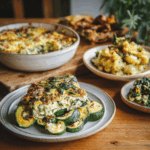Follow Me On Social Media!
The Best Beef Shoulder Roast Recipe
When it comes to hearty comfort food that brings everyone to the table, a beef shoulder roast recipe is hard to beat. This cut is flavorful, affordable, and versatile—making it a weeknight favorite and a weekend showstopper. In this post, you’ll learn how to make it perfectly tender, how to avoid drying it out, and why this beef shoulder roast recipe deserves a spot in your regular rotation.
From Grandma’s Oven to My Own: A Roast That Brings Back Memories
I still remember standing on a step stool next to my grandma as she slid a big, sizzling roast into the oven. The smell would fill the house, making everyone slowly wander into the kitchen. That was the beef shoulder roast —slow-cooked, seasoned just right, and so tender thatyou could pull it apart with a fork. Now, as a 52-year-old chef based in Savannah, Georgia, I’ve made this beef shoulder roast recipe my own, but it still carries that same warm, nourishing feel.
This recipe is exactly what I turn to when I want a meal that feels like home. Whether I’m cooking for family or prepping ahead, this beef shoulder roast recipe gives me everything I need—flavor, comfort, and leftovers. You can pair it with mashed potatoes, shred it for sliders, or tuck it into wraps.
Why This Cut Works So Well
A beef shoulder roast is ideal for slow roasting because it’s rich in connective tissue that melts into tenderness. It starts out tough, but after a few hours, the results are mouthwatering. For more dinner inspiration, try my Easy Beef Recipes or these Roasted Stuffed Bell Peppers.
How to Cook Beef Shoulder Roast Without Drying It Out
Low and Slow Wins the Race
When cooking a beef shoulder roast recipe, patience is key. This cut comes from the hardworking shoulder muscle, which means it needs time to break down and become tender. The trick is low heat and long roasting. I recommend roasting it at 300°F for 3 to 4 hours, depending on size. The slow cook allows the collagen to melt, giving you a juicy roast with incredible depth of flavor. Don’t rush it—high heat will only dry it out and toughen the meat.
Make sure your roast has a good sear before going into the oven. Browning the outside in a hot skillet adds layers of flavor. Then transfer it to a Dutch oven or covered roasting pan with some broth, onions, and herbs. Cover tightly and let the oven do the rest.
For even more weeknight comfort meals, explore my Creamy Mushroom and Spinach Stuffed Chicken or Garlic Parmesan Chicken Pasta—both follow the same simple, nourishing approach.
Moisture Matters: Don’t Skip the Braising Liquid
One common mistake with a beef shoulder roast is forgetting the liquid. This cut needs moisture to stay tender during long cooking. A mix of beef broth, red wine, or even water with a splash of vinegar helps keep everything juicy. The liquid also becomes a rich base for a pan sauce or gravy afterward.
Another tip: don’t open the oven too often. Each peek drops the temperature and extends cook time. Trust the process. Once it’s fork-tender and pulling apart easily, your beef shoulder roast recipe is ready for its spotlight on the table.
Flavor Boosts and Seasoning Tips for a Better Roast
Start With a Strong Seasoning Base
The beauty of a great beef shoulder roast recipe is how it transforms simple ingredients into something deeply flavorful. For seasoning, I keep it classic: kosher salt, cracked black pepper, garlic powder, onion powder, and smoked paprika. You can add fresh rosemary and thyme for aroma, or bay leaves for depth. Don’t be shy with the seasoning—this cut can handle bold flavors.
Before searing, I rub the roast all over with olive oil and the spice blend. That sear locks in the crust and adds a rich layer of umami once the roast hits the oven. You can also add chopped onions, carrots, and celery to the pan for natural sweetness and a perfect base for pan drippings.
If you like a hint of heat or depth, try adding a spoonful of Dijon mustard or Worcestershire sauce to your broth. It balances the roast without overpowering it. For other cozy classics, I recommend trying my Chicken Parmesan Recipe or this Spicy Chicken Sandwich for flavor-packed mains.
Let It Rest—Don’t Skip This Final Step
Once your roast is finished cooking, resist the urge to slice into it right away. Letting your beef shoulder roast recipe rest for at least 15–20 minutes is crucial. It allows the juices to redistribute, which means every slice stays moist and tender.
If you carve too soon, those juices spill out, leaving the roast dry. Cover it loosely with foil and use that time to finish your sides—mashed potatoes, roasted carrots, or even buttered egg noodles all pair wonderfully.
Seasoning, searing, braising, and resting—those are the four pillars of a standout beef roast. Keep them in mind and you’ll be amazed at how this humble cut turns into something memorable.
Serving Ideas and Leftover Magic
Serve It Right: Pairings That Make It a Meal
Once your beef shoulder roast recipe is rested and ready, it’s time to slice or shred and serve. I love carving thick slices and spooning some of that rich pan gravy right on top. Serve it alongside creamy mashed potatoes or roasted garlic carrots for a classic pairing. Add a crusty loaf of bread to soak up every drop of sauce—nothing goes to waste.
If you’re after a lighter option, pair it with a simple green salad and roasted Brussels sprouts. The roast brings the richness, and the veggies balance it with color and crunch. For more main dish ideas that bring comfort to the table, try my Cream of Mushroom Chicken and Rice or this cozy Chicken Salad.
Leftover Love: Reinvent Your Roast
One of my favorite things about this beef shoulder roast recipe is how well it stretches into leftovers. Shred it the next day and warm it gently in leftover juices. Pile it onto sandwich rolls with melted provolone for the best roast beef sandwiches. You can also mix it into pasta, stir it into a veggie soup, or make grain bowls with quinoa and roasted veggies.
Another great trick? Freeze extra portions in airtight containers with a little sauce. It reheats beautifully, giving you a ready-to-go dinner anytime you need it.
The flavor only deepens after a day in the fridge. You’re not just making a meal—you’re setting yourself up for smart, delicious meals all week. This is the kind of recipe that works hard for you, just like it did in my grandma’s kitchen.
Frequently Asked Questions:
What is a beef shoulder roast good for?
A beef shoulder roast is perfect for slow roasting, braising, and stewing. It’s rich in connective tissue and marbling, which makes it ideal for tender, juicy results when cooked low and slow. You can use it in pot roasts, shredded beef sandwiches, tacos, and hearty stews.
Is shoulder roast a tough cut?
Yes, it starts off as a tough cut due to its location in the shoulder area, which gets a lot of use. But with the right cooking method—especially slow roasting—it transforms into a fork-tender, flavorful roast that’s packed with savory depth.
Can you overcook a beef shoulder roast?
You can, especially if cooked at high heat or for too long without moisture. Overcooking dries out the meat and makes it stringy. The best method is to cook it slowly at low heat, with a bit of liquid, until it becomes tender but not mushy.
How do I cook a beef roast without drying it out?
Keep the oven temperature low (around 300°F), use a covered pan to trap steam, and include broth or other liquids to keep the roast moist. Let it rest after cooking to lock in juices. Avoid slicing right away to preserve that moisture.
Conclusion
A beef shoulder roast recipe is one of those go-to meals that brings together comfort, flavor, and nourishment in every bite. From Sunday dinners to easy weeknight leftovers, it’s a roast that works hard and tastes even better the next day. With the right steps—seasoning, searing, slow roasting, and resting—you’ll turn a humble cut into a family-favorite masterpiece.
If you’ve enjoyed this recipe, you’ll also love exploring more slow-cooked comfort meals like my Easy Beef Recipes or hearty options like Creamy Mushroom and Spinach Stuffed Chicken. Let’s keep your kitchen full of flavor, one simply seasoned recipe at a time.





